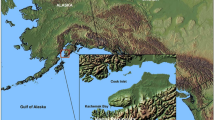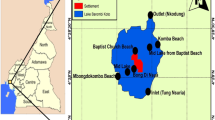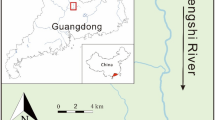Abstract
The former Callahan Mine Site in Brooksville, ME, is an open-pit, hardrock mine site in an intertidal system, thus providing a unique opportunity to evaluate how metal-enriched sediments and overlying water impact estuarine food webs. Copper, zinc, cadmium, and lead concentrations in sediment, whole water, and Atlantic killifish (Fundulus heteroclitus) were evaluated at sites in Goose Pond (GP; Callahan Mine Site) and at reference sites. The metal concentrations of sediment, water, and fish were spatially distinct and significantly greater at the mine site than in the reference estuary. Sediment concentrations were particularly elevated and were above probable effects levels for all four metals adjacent to the tailings pile. Even in this well-mixed system, water metal concentrations were significantly elevated adjacent to the tailings pile, and concentrations of Cu and Zn were above ambient water-quality criteria for chronic marine exposure. Neither organic matter in the sediment nor salinity or pH of the water explained the metal concentrations. Adjacent to the tailings pile, killifish metal body burdens were elevated and were significantly related to both sediment and aqueous concentrations. In conclusion, (1) the contaminated sediment and seepage from the tailings impoundment and waste rock pile no. 3 create a continual flux of metals into the water column, (2) the metals are bioavailable and bioconcentrating as evident in the killifish tissue concentrations, and (3) Callahan Mine is directly affecting metal bioaccumulation in fauna residing in the GP estuary and, potentially, in Penobscot Bay by the way of “trophic nekton relay.”





Similar content being viewed by others

References
Amiard JC, Geffard A, Amiard-Triquet C, Crouzet C (2007) Relationship between the lability of sediment-bound metals (Cd, Cu, Zn) and their bioaccumulation in benthic invertebrates. Estuar Coast Shelf Sci 72(3):511–521
Ayuso RA, Foley NK, Seal RR II, Bove M, Civitillo D, Cosenza A et al (2013) Lead isotope evidence for metal dispersal at the Callahan Cu–Zn–Pb mine: Goose Pond tidal estuary, Maine, USA. J Geochem Explor 126–127:1–22
Baumann Z, Fisher NS (2011) Relating the sediment phase speciation of arsenic, cadmium, and chromium with their bioavailability for the deposit-feeding polychaete Nereis succinea. Environ Toxicol Chem 30(3):747–756
Berry WJ, Hansen DJ, Mahony JD, Robson DL, DiToro DM, Shipley BP et al (1996) Predicting the toxicity of metal-spiked laboratory sediments using acid-volatile sulfide and interstitial water normalizations. Environ Toxicol Chem 15(12):2067–2079
Beyer WN, Dalgarn J, Dudding S, French JB, Mateo R, Miesner J et al (2004) Zinc and lead poisoning in wild birds in the Tri-State Mining District (Oklahoma, Kansas, and Missouri). Arch Environ Contam Toxicol 48(1):108–117
Box GEP (1954) Some theorems on quadratic forms applied in the study of analysis of variance problems.1. Effect of inequality of variance in the one-way classification. Ann Math Stat 25(2):290–302
Bryan GW, Langston WJ (1992) Bioavailability, accumulation and effects of heavy-metals in sediments with special reference to United Kingdom estuaries—A review. Environ Pollut 76(2):89–131
Bryan GW, Langston WJ, Hummerstone LG, Burt GR, Ho YB (1983) An assessment of the gastropod, Littorina littorea, as an indicator of heavy-metal contamination in United Kingdom estuaries. J Mar Biol Assoc U K 63(2):327–345
Buchman MF (2008) NOAA screening quick reference tables, vol 34. Office of Response and Restoration Division, National Oceanic and Atmospheric Administration, Seattle
Chen CY, Folt CL (2000) Bioaccumulation and diminution of arsenic and lead in a freshwater food web. Environ Sci Technol 34(18):3878–3884
Chen CY, Stemberger RS, Klaue B, Blum JD, Pickhardt PC, Folt CL (2000) Accumulation of heavy metals in food web components across a gradient of lakes. Limnol Oceanogr 45(7):1525–1536
Clements WH, Kiffney PM (1994) Integrated laboratory and field approach for assessing impacts of heavy metals at the Arkansas River. Colorado. Environ Toxicol Chem 13(3):397–404
Clements WH, Rees DE (1997) Effects of heavy metals on prey abundance, feeding habits, and metal uptake of brown trout in the Arkansas River, Colorado. Trans Am Fish Soc 126(5):774–785
Colvin MA, Rosen G, Rivera-Duarte I, Earley P, Swope B (2011) Evaluation of tools towards improved assessment of copper bioavailability and toxicity at contaminated sediment sites. Presented as a poster at the 32nd Annual Meeting of the Society of Environmental Toxicology and Chemistry, Boston, MA, Nov 13–17, 2011 [abstract available at boston.setac.org]
Doyle MO, Otte ML (1997) Organism-induced accumulation of iron, zinc and arsenic in wetland soils. Environ Pollut 96(1):1–11
Dutton J, Fisher NS (2011) Salinity effects on the bioavailability of aqueous metals for the estuarine killifish Fundulus heteroclitus. Environ Toxicol Chem 30(9):2107–2114
Dwyer RL (1973) The relation between heavy metal effluents and benthic infaunal community changes in a coastal embayment in Maine. Massachusetts Institute of Technology, Boston
Fernandes JC, Henriques FS (1991) Biochemical, physiological, and structural effects of excess copper in plants. Bot Rev 57(3):246–273
Fisher NS, Hook SE (2002) Toxicology tests with aquatic animals need to consider the trophic transfer of metals. Toxicology 181:531–536
Folt CL, Pickhardt PC, Chen CY (2002) Using plankton food web variables as indicators for the accumulation of toxic metals in fish. In: Wilson SH, Suk WA (eds) Biomarkers of environmental associated disease: technologies, concepts, and perspectives. CRC Press, Boca Raton, pp 287–304
Freedman B, Hutchinson TC (1980) Effects of smelter pollutants on forest leaf litter decomposition near a nickel-copper smelter at Sudbury, Ontario. Can J Bot 8(15):1722–1736
Hall WS, Pulliam GW (1995) An assessment of metals in an estuarine wetlands ecosystem. Arch Environ Contam Toxicol 29(2):164–173
Hu H, Shine J, Wright RO (2007) The challenge posed to children’s health by mixtures of toxic waste: the Tar Creek superfund site as a case-study. Pediatr Clin North Am 54(1):155–172
Hung GA, Chmura GL (2006) Mercury accumulation in surface sediments of salt marshes of the Bay of Fundy. Environ Pollut 142(3):418–431
Kearns PK, Atchison GJ (1979) Effects of trace metals on growth of yellow perch (Perca flavescens) as measured by RNA–DNA ratios. Environ Biol Fish 4(4):383–387
Kiser T, Hansen J, Kennedy B (2010) Impacts and pathways of mine contaminants to bull trout (Salvelinus confluentus) in an Idaho watershed. Arch Environ Contam Toxicol 59(2):301–311
Kneib RT, Stiven AE (1978) Growth, reproduction, and feeding of Fundulus heteroclitus (L) on a North Carolina salt marsh. J Exp Mar Biol Ecol 31(2):121–140
Kneib RT, Weinstein MP, Kreeger DA (2002) Salt marsh ecoscapes and production transfers by estuarine nekton in the southeastern United States. In: Weinstein MP, Kreeger DA (eds) Concepts and controversities in salt marsh ecology. Kluwer Academic Publishers, The Netherlands, pp 267–291
LeBlanc LA, Krahforst C, Aube J, Roach S, Harding G, Hennigar P, et al. (2011) Gulfwatch 2009 data report: Eighteenth year of the Gulf of Maine Environmental Monitoring Program. Gulf of Maine Environmental Monitoring Program, Gulf of Maine Council of the Marine Environment
Lefcort H, Meguire RA, Wilson LH, Ettinger WF (1998) Heavy metals alter the survival, growth, metamorphosis, and antipredatory behavior of Columbia spotted frog (Rana luteiventris) tadpoles. Arch Environ Contam Toxicol 35(3):447–456
MACTEC (2009a) Final baseline ecological risk assessment, Callahan Mine Superfund Site, Brooksville, Maine. Project no. 3612-06-2047-27. MACTEC Engineering and Consulting, Inc., Portland
MACTEC (2009b) Remedial investigation report. Volumes 1A, 1B, 1C, and 1D. Callahan Superfund Site, Brooksville, Maine. Project no. 3612062047. MACTEC Engineering and Consulting, Inc., Portland
MACTEC (2009c, July) Final operable unit 1 feasibility study, Callahan Mine Superfund Site, Brooksville, Maine. Project no. 3612062047. MACTEC Engineering and Consulting, Inc., Portland
Maes GE, Raeymaekers JAM, Hellemans B, Geeraerts C, Parmentier K, De Temmerman L et al (2013) Gene transcription reflects poor health status of resident European eel chronically exposed to environmental pollutants. Aquat Toxicol 126:242–255
Malcoe LH, Lynch RA, Kegler MC, Skaggs VJ (2002) Lead sources, behaviors, and socioeconomic factors in relation to blood lead of Native American and white children: a community-based assessment of a former mining area. Environ Health Perspect 110:221–231
Mason RP (2002) The Bioaccumulation of mercury, methylmercury, and other toxic elements into pelagic and benthic organisms. In: Newman MC, Roberts MH, Hale RC (eds) Coastal and estuarine risk assessment. Lewis, New York, pp 127–149
Mathews T, Fisher NS (2008) Trophic transfer of seven trace metals in a four-step marine food chain. Mar Ecol Prog Ser 367:23–33
Mathews T, Fisher NS (2009) Dominance of dietary intake of metals in marine elasmobranch and teleost fish. Sci Total Environ 407(18):5156–5161
McCarty LS, Mackay D (1993) Enhancing ecotoxicological modeling and assessment. Environ Sci Technol 27(9):1719–1728
McGeer JC, Brix KV, Skeaff JM, DeForest DK, Brigham SI, Adams WJ et al (2003) Inverse relationship between bioconcentration factor and exposure concentration for metals: implications for hazard assessment of metals in the aquatic environment. Environ Toxicol Chem 22(5):1017–1037
McGrath JA, Paquin PR, Di Toro DM (2002) Use of the SEM and AVS approach in predicting metal toxicity in sediment: A fact sheet on environmental risk assessment. International Council of Mining and Metals. Available at: www.icmm.com. Accessed 22 Feb 2013
McKinley AC, Miskiewicz A, Taylor MD, Johnston EL (2011) Strong links between metal contamination, habitat modification and estuarine larval fish distributions. Environ Pollut 159(6):1499–1509
McMahon KW, Johnson BJ, Ambrose WG (2005) Diet and movement of the killifish, Fundulus heteroclitus, in a Maine salt marsh assessed using gut contents and stable isotope analyses. Estuaries 28(6):966–973
Metcalf and Eddy, Inc. (2003) Conceptual model and RI/FS SOW, Callahan Mining Superfund Site, Brookville, Maine. United States Environmental Protection Agency. Available at: www.epa.gov/ne/superfund/sites/callahan/44290.pdf. Accessed 22 Jan 2013
Mittal AK (2011) Abandoned mines: Information on the Number of hardrock mines, cost of cleanup, and value of financial assurances statement. Natural Resources, Subcommittee on Energy and Mineral Resources. United States Government Accountability Office
Otte ML, Haarsma MS, Broekman RA, Rozema J (1993) Relation between heavy-metal concentrations in salt-marsh plants and soil. Environ Pollut 82(1):13–22
Pascoe GA, Blanchet RJ, Linder G, Palawski D, Brumbaugh WG, Canfield TJ et al (1994) Characterization of ecological risks at the Milltown Reservoir Clark-Fork River Sediments Superfund Site, Montana. Environ Toxicol Chem 13(12):2043–2058
Pope ND, O’Hara SCM, Imamura M, Hutchinson TH, Langston WJ (2011) Influence of a collapsed coastal landfill on metal levels in sediments and biota—A portent for the future? J Environ Monit 13(7):1961–1974
Poulton BC, Allert AL, Besser JM, Schmitt CJ, Brumbaugh WG, Fairchild JF (2010) A macroinvertebrate assessment of Ozark streams located in lead-zinc mining areas of the Viburnum Trend in southeastern Missouri, USA. Environ Monit Assess 163(1–4):619–641
Rainbow PS, Kriefman S, Smith BD, Luoma SN (2011) Have the bioavailabilities of trace metals to a suite of biomonitors changed over three decades in SW England estuaries historically affected by mining? Sci Total Environ 409(8):1589–1602
Rajakaruna N, Harris TB, Clayden SR, Dibble AC, Olday FC (2011) Lichens of the Callahan Mine, a copper- and zinc-enriched Superfund Site in Brooksville, Maine, USA. Rhodora 113(953):1–31
Reinfelder JR, Fisher NS, Luoma SN, Nichols JW, Wang WX (1998) Trace element trophic transfer in aquatic organisms: a critique of the kinetic model approach. Sci Total Environ 219(2–3):117–135
Rossi N, Jamet J-L (2008) In situ heavy metals (copper, lead and cadmium) in different plankton compartments and suspended particulate matter in two coupled Mediterranean coastal ecosystems (Toulon Bay, France). Mar Pollut Bull 56(11):1862–1870
Schaider LA, Senn DB, Brabander DJ, McCarthy KD, Shine JP (2007) Characterization of zinc, lead, and cadmium in mine waste: Implications for transport, exposure, and bioavailability. Environ Sci Technol 41(11):4164–4171
Schlekat CE, Lee B, Luoma SN (2002) The bioaccumulation of mercury, methylmercury, and other toxic elements into pelagic and benthic organisms. In: Newman MC, Roberts MH, Hale RC (eds) Coastal and estuarine risk assessment. Lewis, New York, pp 151–188
Stewart GM, Fowler SW, Teyssie JL, Cotret O, Cochran JK, Fisher NS (2005) Contrasting transfer of polonium-210 and lead-210 across three trophic levels in marine plankton. Mar Ecol Prog Ser 290:27–33
United States Environmental Protection Agency (2009) Callahan Mining Corporation public information meeting for proposed cleanup plan. SDMS# 452697. USEPA. Available at: http://www.epa.gov/region1/superfund/sites/callahan/452697.pdf. Accessed 22 Jan 2013
United States Environmental Protection Agency (2012) Abandoned mine lands: NPL mining sites. Available at: http://www.epa.gov/aml/amlsite/npl.htm. Accessed 21 Jan 2013
Valiela I, Wright JE, Teal JM, Volkmann SB (1977) Growth, production and energy transformations in salt-marsh killifish Fundulus heteroclitus. Mar Biol 40(2):135–144
van der Merwe D, Carpenter JW, Nietfeld JC, Miesner JF (2011) Adverse health effects in Canada geese (Branta canadensis) associated with waste from zinc and lead mines in the tri-state mining district (Kansas, Oklahoma, and Missouri, USA). J Wildl Dis 47(3):650–660
Velleux ML, Julien PY, Rojas-Sanchez R, Clements WH, England JF Jr (2006) Simulation of metals transport and toxicity at a mine-impacted watershed: California Gulch, Colorado. Environ Sci Technol 40(22):6996–7004
Vieira LR, Gravato C, Soares A, Morgado F, Guilhermino L (2009) Acute effects of copper and mercury on the estuarine fish Pomatoschistus microps: linking biomarkers to behavior. Chemosphere 76(10):1416–1427
Wang WX, Stupakoff I, Fisher NS (1999) Bioavailability of dissolved and sediment-bound metals to a marine deposit-feeding polychaete. Mar Ecol Prog Ser 178:281–293
Weis P, Weis JS (1976) Effects of heavy-metals on fin regeneration in killifish, Fundulus heteroclitus. Bull Environ Contam Toxicol 16(2):197–202
Weis JS, Weis P (1989) Tolerance and stress in a polluted environment. Bioscience 39(2):89–95
Whitehead A, Pilcher W, Champlin D, Nacci D (2011a) Common mechanism underlies repeated evolution of extreme pollution tolerance. Proc R Soc B Lond Biol Sci 279(1728):427–433
Whitehead A, Roach JL, Zhang S, Galvez F (2011b) Genomic mechanisms of evolved physiological plasticity in killifish distributed along an environmental salinity gradient. Proc Natl Acad Sci U S A 108(15):6193–6198
Woods Hole Group I (2007) Hydrodynamic observations at the former Callahan Mine property, Brooksville, ME: August 24–October 29, 2006 Woods Hole Group, Inc., East Falmouth, MA
Xu Y, Wang WX (2002) Exposure and potential food chain transfer factor of Cd, Se and Zn in marine fish Lutjanus argentimaculatus. Mar Ecol Prog Ser 238(0171–8630):173–186
Zamuda CD, Sunda WG (1982) Bioavailability of dissolved copper to the American oyster Crassostrea virginica.1. Importance of chemical speciation. Mar Biol 66(1):77–82
Zhang L, Wang W-X (2007) Size-dependence of the potential for metal biomagnification in early life stages of marine fish. Environ Toxicol Chem 26(4):787–794
Acknowledgments
The authors thank Edward Hathaway for time and expertise on this project and Bart Hoskins for comments in the early stages of analyzing the data. Metal concentrations were measured in Brian Jackson’s laboratory at the Dartmouth Trace Element Analysis core by R. Arthur Baker and Vivien Taylor. This publication was made possible by National Institutes of Health (NIH) Grant No. P42 ES007373 from the National Institute of Environmental Health Sciences. Its contents are solely the responsibility of the authors and do not necessarily represent the official views of the NIH or the USEPA. We are grateful to the Center of Environmental Health Sciences at Dartmouth College for the pilot funds, which made this project possible.
Author information
Authors and Affiliations
Corresponding author
Electronic supplementary material
Below is the link to the electronic supplementary material.
Rights and permissions
About this article
Cite this article
Broadley, H.J., Buckman, K.L., Bugge, D.M. et al. Spatial Variability of Metal Bioaccumulation in Estuarine Killifish (Fundulus heteroclitus) at the Callahan Mine Superfund Site, Brooksville, ME. Arch Environ Contam Toxicol 65, 765–778 (2013). https://doi.org/10.1007/s00244-013-9952-y
Received:
Accepted:
Published:
Issue Date:
DOI: https://doi.org/10.1007/s00244-013-9952-y



